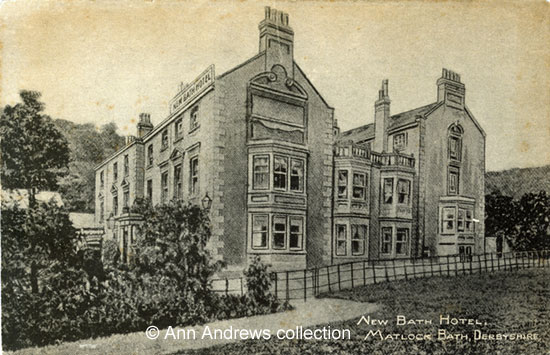|
Images Index> Matlock Bath, 20th and 21st Century Images> This page |
| Matlock Bath: New Bath Hotel (3) |
| Matlock Bath : Twentieth Century Photographs, Postcards, Engravings & Etchings |
|
|
|||||||||||||||||||
There are other canted windows, each with a flat roof, on what were the north and south wings with the gable ends, also shown on Adam's engraving so are ealier than those of the infilled section. The north wing's bay window is slightly raised above the level of the others as there is a small extra window underneath for the eighteenth century "plunge pool", which is in the basement. The extension overlooking the garden, shown on the right of the top image, was designed by the Matlock Bridge architect Mr. George Edward Statham. In March 1885 the local Board had received a letter from him enclosing tracings of the proposed new wing[2]. This part of the hotel has another canted bay, with the windows on two storeys; there is a shallow roof covering this bay. The railings between Bath Terrace and the grass are not shown in the booklet produced around 1900 for Mr. Clulow and the New Bath Hotel Company. They could have been erected when tufa was being quarried on the far side of the grassed area (Saxton's Green), next to the main road a few feet below (see previous page). In the winter of 1901 the hotel, by then managed by Robert Rimmer, was advertised as a first-class family hotel that was both warm and comfortable, sheltered from cold winds and with a First Class Table[3]. It was promoted as a venue for parties and balls as it had a large, sprung dance floor[4]. It also hosted dinners such as the one for the Midland Institute of Engineers when they visited Mill Close Mine at Darley in 1908[5]. Large groups, such as the London Society of Derbyshire Men, stayed at the hotel whilst touring the area[6]. There were two problems for the hotel in 1910. The first was when the stables adjoining the hotel caught fire in January that year. Fortunately, there were no horses in the stalls as the flames spread and Matlock Council Fire Brigade were summoned by telephone. They put out the flames in half an hour, but the incident attracted a large crowd[5]. In October the New Bath Hotel Company Limited, which had been formed in 1898, appointed a receiver and was voluntarily wound up[8].
There is more about the New Bath Hotel
|
||||||||||||||||||||
"Matlock Bath, New Bath Hotel". No publisher. Not posted. Has Edward VII half penny stamp stuck on the back. 2. "New Bath Hotel, Matlock Bath, Derbyshire". Published by Littlebury & Co., Worcester. No number and unused. Postcards in the collection of, provided by and page researched by, written by and © Ann Andrews. Intended for personal use only. |
||||||||||||||||||||
References (coloured links are to more information elsewhere on this web site): [1] Adam, W. (1845, 4th edition) "The Gem of the Peak; or Matlock Bath and Its Vicinity". ... The 1851 and 1857 editions have also been checked. [2] "Derbyshire Advertiser and Journal", 6 March 1885. Matlock Bath Local Board. [3] "Derby Daily Telegraph", 23 December 1901. [4] Advertisement in the "Derbyshire Times and Chesterfield Herald", 4 January 1902. [5] "Derby Daily Telegraph", 20 Jul 1908. [6] "Derby Daily Telegraph", 4 Jun 1903. [5] "Derby Daily Telegraph", 15 January 1910. Large crowds also gathered when there were other fires in Matlock Bath, notably at the Royal Hotel and Glove Factory fires at the end of the 1920s. The stable block was sub-let to William Furniss of Matlock in 1910. [8] "Derby Daily Telegraph",
29 October 1910. The case was heard in the Chancery Division, before
Mr. Justice Eve. |
||||||||||||||||||||


















